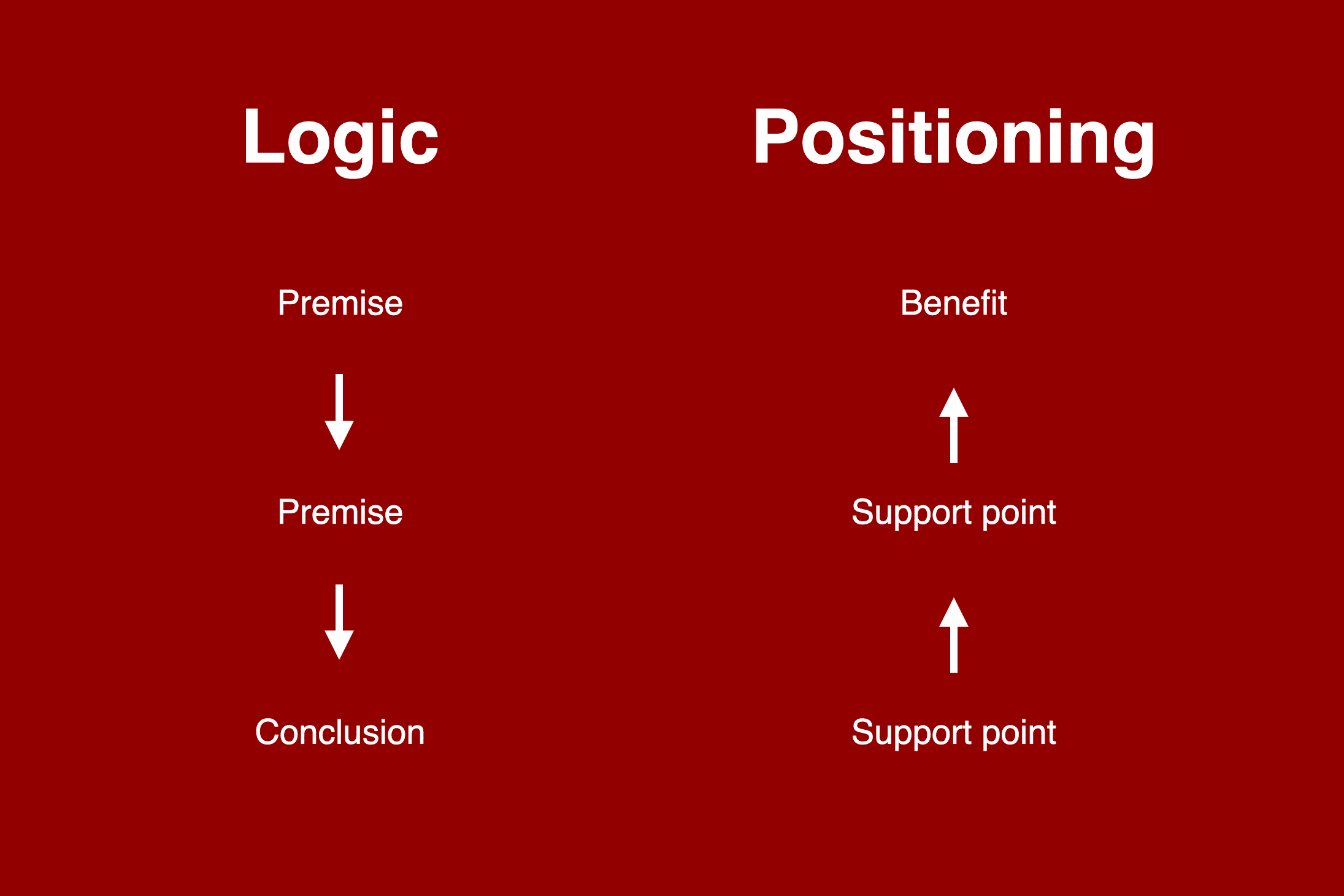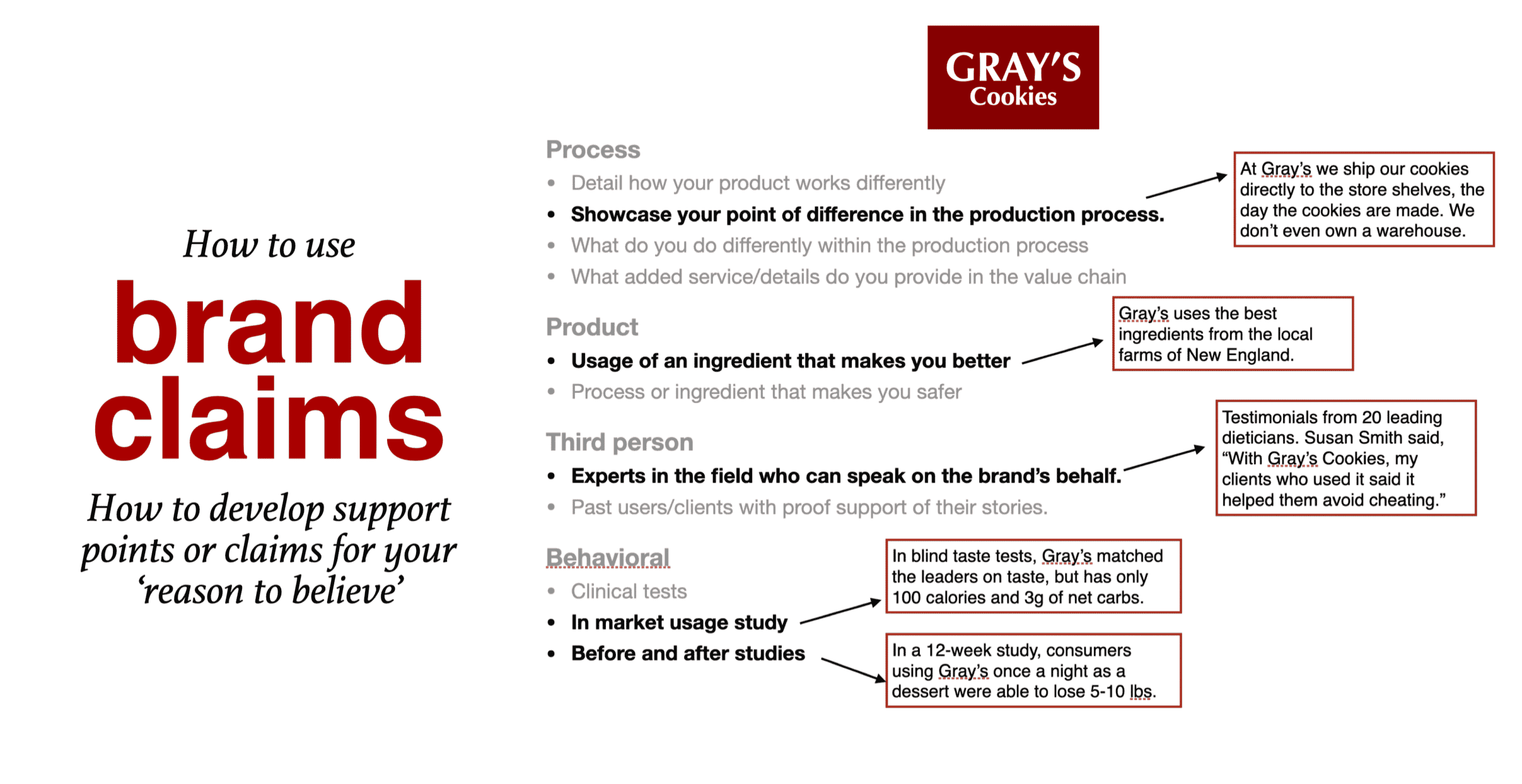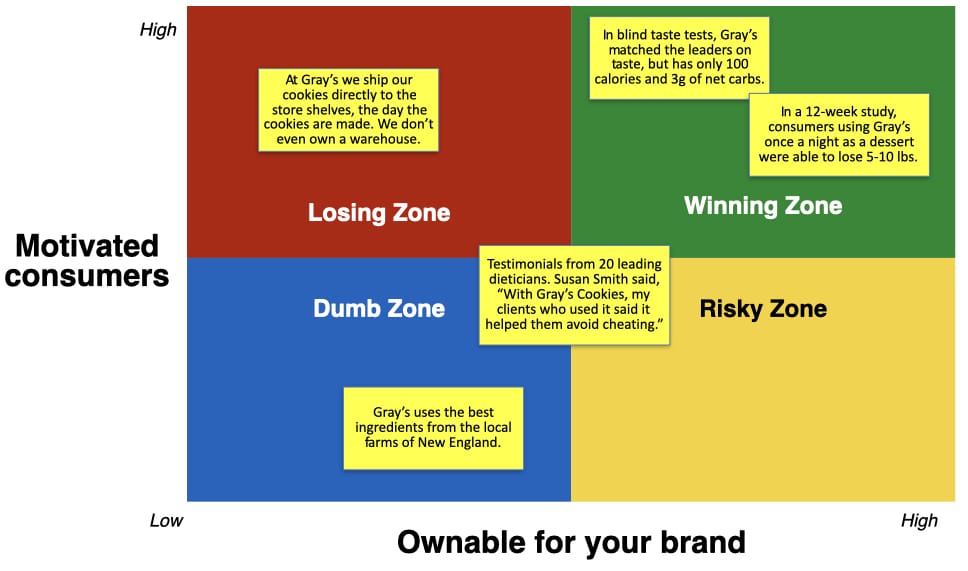Your brand claims bring your reasons to believe to life, with creativity that backs up your main consumer benefit. Brands have four choices: be better, different, cheaper, or else not around for long.
If you do not define your brand, then you run the risk of the possibility that your competitors will define your brand. And you might not like it.
Four elements make up a brand positioning statement, including who you serve, where you play, where will you win, and why consumers should believe you. These are the consumer target, marketplace definition, the consumer benefit, and support points. Brand claims fit in with the support points.
To illustrate, click to zoom in.
Types of claims
There are four types of brand claims you can use on your brand:
Process support
- How your product works differently
- Showcase what you do differently within the production process
- What added service do you provide in the value chain
Product claims
- Usage of an ingredient that makes your brand better
- Process or ingredient that makes your brand safer
- A process that makes your brand cheaper
Third-person endorsement
- Experts in the field who can speak on your brand’s behalf.
- Past users/clients with proof support of stories or reviews
- Recognized awards, such J.D. Power
Behavioral results
- Clinical tests
- In market usage study
- Before and after studies
Support points
I took one logic class at university, and the only thing I learned was “premise-premise conclusion.” It was an easy class, but a life-long lesson that has stuck with me. Here is a classic logical argument statement:
- All fish live in water (premise)
- Tuna are fish (premise)
- Therefore, tuna live in the water (conclusion)

If pure logic teaches us that two premise points are good enough to draw out any conclusion, then you only need two “reasons to believe” (brand claims).
Brands that build concepts with a laundry list of RTBs are not doing their job in making focused decisions on what support points are required.
With consumers seeing 5,000 brand messages per day, having a long list of support points risks making their brand communications a cluttered mess. Brand claims can be a useful tool in helping to support your RTB, yet the RTB should never be the conclusion.
Beloved Brands playbook
Our Beloved Brands playbook goes in depth on everything you need to build a brand consumers will love. Learn about strategic thinking, brand positioning, writing brand plans, advertising decisions, media planning, marketing analytics, and financials.

Our readers tell us they keep our Beloved Brands playbook close by for whenever they need to take on a new project. Clearly, we are thrilled that 89% of Amazon reviewers have given Beloved Brands a 5-star rating. Also, we wrote a B2B Brands playbook and a Healthcare Brands playbook.
Brand Strategy
Does your brand have unrealized potential?
Here are five questions you need to be able to answer about your brand:
- First, can you describe your brand in seven seconds in a way that motivates consumers to engage and in a space that is own-able for your brand?
- Second, are you making the right investments that will create a market impact for your brand, and lead to a performance result for your business?
- Next, does everyone on your team know their role and know how they contribute to building a successful brand?
- Does your marketing execution establish your desired brand positioning and move customers to purchase?
- Finally, are you investing in your people to ensure they make smarter decisions and produce exceptional work that drives business growth?
If you cannot answer these five questions, your team will be confused. Clearly, your brand investments will be scattered and won’t pay back. You will see inconsistent execution in the market. The consumer will not know how to define your brand. And, you won’t grow! It is time to make decisions.
We help brands define themselves so they can drive new growth opportunities.
At Beloved Brands, our brand strategy process will help you define your brand and map out a strategic plan for the best possible future for your brand.
We will help you define your brand positioning statement and narrow down to a brand idea that is your seven second pitch. Then, we challenge you to select the right strategic investments for your brand, and build a strategic plan that everyone can follow.
Importantly, you need your marketing execution to build your brand reputation in the market and moves customers along their purchase journey.
M A R K E T I N G B O O K
b2b brands
the b2b playbook for how to create a brand your customers will love
As a B2B marketer, you know that the key to driving growth is a strong brand. But how do you develop and execute a winning B2B brand strategy? Look no further than the B2B Brands playbook.
Prepare to think differently about your B2B brand strategy with B2B Brands. We want to challenge you with thought-provoking questions and take you through our process for defining your brand positioning. Our goal is to expand your mind to new possibilities for your brand by using real-life examples of successful B2B brand positioning strategies.
We’ll start by showing you how to create a brand plan that’s easy for everyone to follow, ensuring that all stakeholders understand how they can contribute to your brand’s success. Moreover, we guide you through the creative execution process, including how to write an inspiring brief and make decisions to achieve smart and innovative communications.
Finally, we’ll teach you new methods to analyze your brand’s performance through a deep-dive business review.
Our B2B Brands playbook offers a wealth of knowledge and insights, including B2B case studies and examples to help you learn new techniques. It’s no wonder that 85% of our Amazon reviewers have given us a 5-star rating. So, join us on this journey to unleash the potential of your B2B brand.













